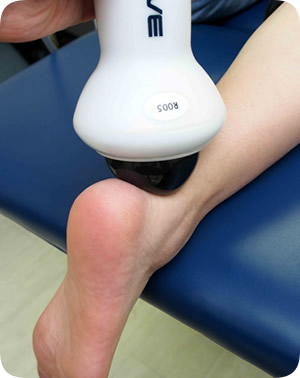Surgeries and Other Alternatives
 There are a number of treatment options that can be used if AT becomes a severe, chronic condition. These methods are often very serious and come with their own set of risks. Surgery may be considered if the pain of AT does not improve after 6 months of other treatment options. The specific kind of AT that would require surgery also depends on the location of the tendonitis and how much damage has occurred in the tendon. One specific type of surgery is called gastrocnemius recession. This is where the calf muscles are surgically lengthened to relieve stress on the Achilles tendon caused by the muscles being too tight. Lengthening the calf muscle increases the motion of the ankle. This surgical method has been found to be beneficial for sufferers of AT who have difficulty flexing their feet, even though they do consistent stretching exercises. Gastrocnemius recession has a low risk of complication; however, nerve damage is a possibility. Another type of surgery is Debridement and repair surgery. In cases of AT where the tendon is less than 50% damaged, an operation is performed where the unhealthy portion of the tendon is removed and the remaining tendon is repaired with sutures. If the tendon is damaged by more than 50%, a tendon transfer may be performed. The tendon that moves your big toe back and forth is removed and inserted where the unhealthy portion of the tendon would be. Extracorporeal ShockWave Therapy (ESWT) is where high-energy shock wave impulses are applied to begin the healing process in the damaged tendon. This procedure is not as invasive or serious as surgery and there is little risk involved. However, ESWT has not displayed consistent results in research, so there is little information regarding the applicability of this treatment option. A cortisone injection is a process where steroids are inserted into the affected area to help ease inflammation. Cortisone injections have been known to have some success, but the risk of infection around the injection site is fairly high. After more than 6 months of treating your AT, if there is still no sign of improvement or your symptoms has worsened, it’s time to seek a professional opinion about what is going on. In fact, it is advisable to seek more than one professional opinion, due to the fact that you may be misdiagnosed. It is also possible that you are not performing a scheduled, specific treatment option for yourself, and a physician should be able to plan one out with you. If after 6 months of treating AT, you have moved to more invasive techniques such as surgery, it may be a case of misdiagnoses. If you’ve been treating your AT by yourself for 6 months, it’s quite possible you may need just a little bit of extra insight by a licensed professional. Doctors who specialize in sports medicine are the most knowledgeable about treating and recovering from Achilles tendonitis.
There are a number of treatment options that can be used if AT becomes a severe, chronic condition. These methods are often very serious and come with their own set of risks. Surgery may be considered if the pain of AT does not improve after 6 months of other treatment options. The specific kind of AT that would require surgery also depends on the location of the tendonitis and how much damage has occurred in the tendon. One specific type of surgery is called gastrocnemius recession. This is where the calf muscles are surgically lengthened to relieve stress on the Achilles tendon caused by the muscles being too tight. Lengthening the calf muscle increases the motion of the ankle. This surgical method has been found to be beneficial for sufferers of AT who have difficulty flexing their feet, even though they do consistent stretching exercises. Gastrocnemius recession has a low risk of complication; however, nerve damage is a possibility. Another type of surgery is Debridement and repair surgery. In cases of AT where the tendon is less than 50% damaged, an operation is performed where the unhealthy portion of the tendon is removed and the remaining tendon is repaired with sutures. If the tendon is damaged by more than 50%, a tendon transfer may be performed. The tendon that moves your big toe back and forth is removed and inserted where the unhealthy portion of the tendon would be. Extracorporeal ShockWave Therapy (ESWT) is where high-energy shock wave impulses are applied to begin the healing process in the damaged tendon. This procedure is not as invasive or serious as surgery and there is little risk involved. However, ESWT has not displayed consistent results in research, so there is little information regarding the applicability of this treatment option. A cortisone injection is a process where steroids are inserted into the affected area to help ease inflammation. Cortisone injections have been known to have some success, but the risk of infection around the injection site is fairly high. After more than 6 months of treating your AT, if there is still no sign of improvement or your symptoms has worsened, it’s time to seek a professional opinion about what is going on. In fact, it is advisable to seek more than one professional opinion, due to the fact that you may be misdiagnosed. It is also possible that you are not performing a scheduled, specific treatment option for yourself, and a physician should be able to plan one out with you. If after 6 months of treating AT, you have moved to more invasive techniques such as surgery, it may be a case of misdiagnoses. If you’ve been treating your AT by yourself for 6 months, it’s quite possible you may need just a little bit of extra insight by a licensed professional. Doctors who specialize in sports medicine are the most knowledgeable about treating and recovering from Achilles tendonitis.

